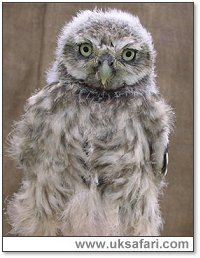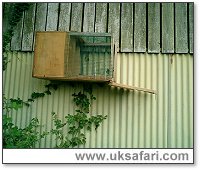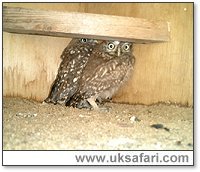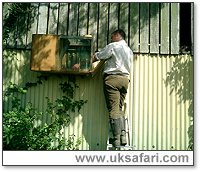
|

|
|
 Sent
to you Sent
to you
by e-mail
|
|
Simply
enter your details and hit the send button
more
info |
|


Click Here

Links
Advertise
Terms of Use
Contributors
About Us
Contact Us
|
 |
Go back
 | Bookmark
| Bookmark
 | Print Page
| Print Page  | E-Mail Us
| E-Mail Us 
Back to the Wild
By Julie Finnis,
Head Warden, Suffolk Owl Sanctuary
Suffolk Owl Sanctuary takes in
sick and injured wild owls and birds of prey. They are treated according to their needs and where possible released
back to the
wild. Julie Finnis explains how it's done...

Little Owl Chick
|
|
UK
Safari Tip:
Get help identifying birds with the superbly illustrated "Top 50
Garden Birds" identification chart - click
here
|
|
When orphaned owls like this one are brought to the Suffolk Owl anctuary we handle them as little as possible before we attempt
to return them to nature.
A wild owl needs to be kept wary of humans. An owl which has been hand-raised believes
that humans are its parents, and grows to rely on humans to provide it with food. This
deters it from learning to hunt properly for itself.
The method we use for returning young owls to the wild is called "Hacking Back". It involves putting the youngsters into what's known as a
"hack box". where they are fed, and are able to see the outside world.
The hack box is a slightly extended and enlarged nest box enclosed with a removable mesh grill.
If we are brought a single baby owl we hope to find a companion for it. Placing two birds together allows them to learn from each other, and they will be less inclined to imprint onto humans. We place the babies inside the box and secure the front in place so that they cannot get out and predators cannot get in.

A hack box fixed to the rear of an
old barn facing onto a set-aside field.

Two orphaned Little Owls are
housed inside.

We visit the box twice daily, taking
food and fresh water.
In the early stages the owls cannot get out of the box, but as they grow they can
view the world outside. At the right moment we remove the front of the
box so they are free to leave when they're ready.
In most cases the young owls will continue to treat the box as home, exploring their
surroundings, but returning to pick up the food that we continue to provide.
If they stay close to the box we start to reduce the quantity of food, encouraging them to hunt for themselves. Over the next couple of weeks they will become independent.

Suffolk Owl Sanctuary
Little Owl wallpaper for your desktop
More about Little Owls
UK Safari Owl Section
 Understanding Owls: Biology Management Breeding Training (Jemima Parry-Jones) Understanding Owls: Biology Management Breeding Training (Jemima Parry-Jones)
A guide to caring for owls, covering topics such as: biology; taxonomy; housing; equipment; incubation; rearing; and training and flying owls.
 The Really Useful Owl Guide
The Really Useful Owl Guide
(Jemima Parry-Jones)
|
 |

|